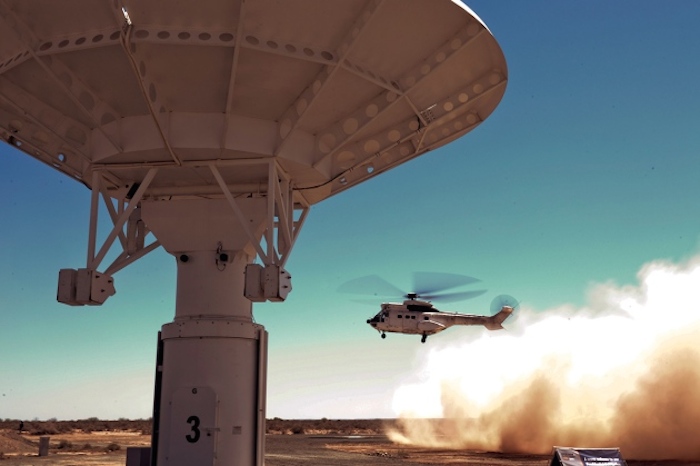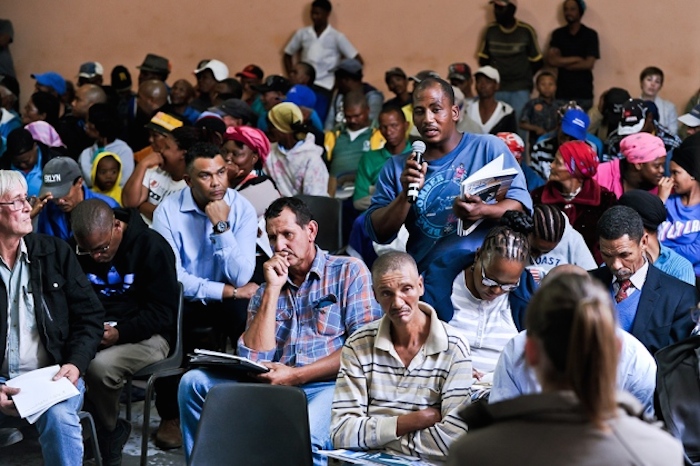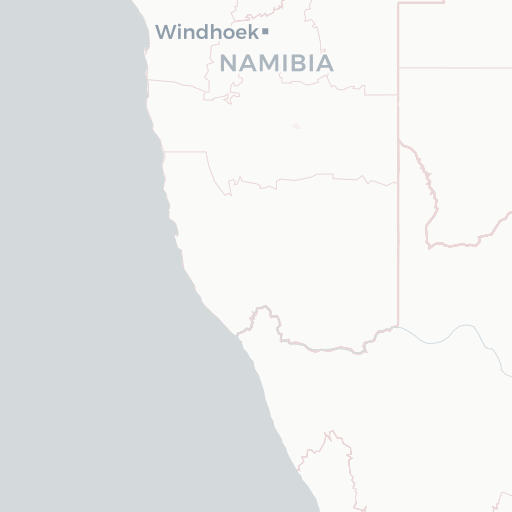.
22.06.2016
Giant SKA telescope rattles South African community
Struggle in Northern Cape province highlights a balancing act that scientists leading gigantic projects face.


In African desert, telescope project seeks clear skies in cruel terrain
The Square Kilometre Array will be the world’s most powerful radio telescope, opening new frontiers in our understanding of the universe. But the builders have to contend with an unforgiving climate and other formidable challenges first,Geoffrey York reports

The world’s most powerful radio telescope, a Canadian-backed project known as the Square Kilometre Array, is currently under construction in a remote region of South Africa.
SKA SA
In the desolate rocky plains of the Great Karoo, the dangers are endless. Scorpions and puff adders are underfoot. The harsh sun beats down, interrupted only by occasional lightning storms. Temperatures range from stifling heat to freezing cold.
But at night, in the vast empty darkness, the stars are impossibly bright and clear. And it is the stars that have lured a Canadian-backed project to build the world’s most powerful radio telescope, with the potential to unlock the deepest secrets of the universe.
For the engineers who are now assembling the telescope in this forbidding landscape, the wind whipping down from the Karoo hills is one of the main worries. Gusts of wind can flip over the giant 13.5-metre-wide dish antennas that form the telescope, so construction is halted as soon as the wind rises.
Yet, the biggest threats are invisible: signals from a cellphone or laptop, emitting enough interference to destroy a day of data from the antennas. To combat this hazard, electronic devices are banned for many kilometres around the site, or kept in underground bunkers behind heavily shielded doors.
The challenges of this pioneering telescope project are extraordinary, but the payoff will be spectacular. The sprawling collection of radio antennas, dubbed the Square Kilometre Array (SKA) because of an early estimate of the size of their collecting surface, could some day find clues to the origins of the universe, the forces that create planets, the nature of dark matter, and the mysteries of possible life in other galaxies.
Like the thousands of receptors in the compound eye of a fly, the project will build its image of the universe from thousands of futuristic antennas, resembling satellite dishes, which will be electronically combined with the help of Canadian technology.
The South African antennas, although still in an early precursor phase, have already discovered more than 1,300 galaxies in a patch of sky where only 70 were previously known to exist. The images stunned astronomers around the world when they were revealed in July.
The full telescope, to be completed by 2024, will be physically divided between South Africa and Australia. But eight other countries, including Canada, will be key partners in the consortium that supports the $2-billion (U.S.) project.
Negotiations among the consortium members, now under way, will set up a council to determine the size of the financial and technological investments by Canada and the other partners. Canada has some of the world’s leading expertise in the supercomputers and correlators that will be crucial to the telescope project.
Here in the remote Karoo flatland, sheep farmers and townsfolk are wary of the project, fearing the potential expropriation of their land and the silencing of their telecommunications. Across a vast swath of 132,000 hectares of farmland, a traditional way of life could be lost, and some farmers are skeptical of whether the science-related jobs will be enough to replace it. “Precious agricultural land is under threat,” says a group called Save the Karoo.
Yet, the project’s benefits are huge. The telescope will be far more sensitive than anything else in existence, allowing far fainter signals to be analyzed.
“The most profound questions that a philosopher might ask are: ‘What is the universe made of’ and ‘Are we alone?’” said Bryan Gaensler, the Canadian SKA science director.
“And the SKA is aiming to answer both of those questions – as well as others, like ‘how did everything begin, how will it end.’ These are all really deep questions that people have been asking for centuries, and nobody ever thought there would be answers to them,” Mr. Gaensler told The Globe and Mail in an interview.
“We’ll be able to watch planets form, and then understand if there’s life on them. It’s exciting. When I started to see the preliminary images, I was just blown away.”
Those first images were produced from just 16 of the planned 64 antennas in the SKA’s first phase, known as MeerKAT. (The name is derived from an earlier precursor, the Karoo Array Telescope, with a nod to the popular African desert mammal and the Afrikaans word for “more.”)
The Globe was recently allowed to visit the guarded MeerKAT site, at the end of a dusty, 90-kilometre drive from the nearest town. Road signs warned of wandering sheep, but there were few signs of life, aside from stony fields of scrub bush and cactus and the occasional lonely farm building.
Watch: A flyover view of the South African array
Engineers disclosed that they have now erected 34 antennas and are hoping to finish the 64th antenna by October, 2017. Many of the gleaming white antennas are already linked into the computers. Their cooling systems are humming in the mid-day heat, their wind detectors are monitoring the breezes, and there is a quiet whirring noise as the giant dishes are adjusted to focus on a new spot in the sky.
The antennas here will produce such an overwhelming tsunami of Big Data that powerful supercomputers will be needed to process it. Not far from the antennas is an underground bunker, where data processing computers will be housed in so-called Faraday cages, behind sliding metal doors, to prevent them from emitting radio interference. The data flow is so massive that it is compressed here, before being transmitted to research centres for analysis.
In a nearby dormitory for the project’s staff, the house rules say: “Personal electronic devices may only be used in shielded rooms.” Red and black “danger” signs are posted on the walls, warning: “No bluetooth, no cellphones, no wifi. Your radio signals will damage our equipment.”
Even ordinary gasoline-powered vehicles are barred from the site, because their spark plugs can cause interference. Only diesel vehicles are used, to protect the precious data arriving from the dishes.
“In the old days, the cost of the telescope was the metal beams, but these days there’s a recognition that the supercomputer attached to the telescope is what creates the magic and the potential for discovery,” Mr. Gaensler said.
“The philosophy now is that the computer is the telescope. It’s a whole new way of doing science. It’s not about getting the sharpest, prettiest picture – it’s about dealing with incredible torrents of data and finding the needles in the haystacks.”
The computers will be crucial because the SKA will generate data volumes that can be measured in exabytes (one billion gigabytes). It will be bigger than the current data rate of the entire Internet.
“It’s a big challenge, because we’re pushing into realms of processing terrain that we haven’t seen before,” said Sean Dougherty, director of the Dominion Radio Astrophysical Observatory in Penticton, B.C.
“We’ve only visited it for very brief moments in experiments like the Large Hadron Collider. That’s quite different from the model of the SKA, where data-taking will go over many hours, so the volumes of data are going to be unprecedented.”

Canadian-designed supercomputers will help the telescope generate images by combining the signals from the antennas.
SKA SA
Unlike optical telescopes, a radio telescope can peer through the thick layers of dust surrounding the galaxies. And because of its South African location, it will provide a much clearer view of the heart of our own galaxy, the Milky Way, which is more readily visible from the Southern Hemisphere.
Canada, led by the National Research Council and a group of Canadian universities, was one of the six founding members of the earliest SKA consortium in 2000. Today, it is one of 10 member countries in the SKA Organization and appoints two representatives to the SKA board of directors.
The National Research Council is already supplying technology to the MeerKAT antennas in South Africa, including low-noise amplifiers for the radio receivers. It also helped develop cost-effective carbon-fiber composite materials for use in the receiver systems.
And Canada has world-leading expertise in designing the supercomputers and correlators that will generate the images from the SKA telescope by combining the signals from the antennas.
“There’s an enormous Canadian contribution,” Mr. Gaensler said. “We really hope to see, in a metaphorical sense, Made-in-Canada stickers all over the equipment and all over the discoveries.”
Canadian astronomers are among the world’s leading experts on some of the SKA’s science priorities – including the study of pulsars to understand gravity, and the detection of atomic hydrogen to learn how the universe evolved.
“We can figure out how the first galaxies formed, how the first stars formed,” Mr. Dougherty told The Globe.
“There will be interesting phenomena we’ll discover that we had no idea existed before. The Southern Hemisphere, unlike the Northern Hemisphere, has really been starved of significant collecting areas. When you’ve got more collecting area, the images are much more sensitive, so you can go deeper and see fainter objects.”
The SKA is a huge boost for African science, with spinoffs aiming to strengthen radio astronomy in eight other African nations. Canada is helping organize a conference of African astronomers in Mauritius in May to hear their proposals for SKA research.
The small Karoo towns near the telescope site, where unemployment is high, are among the beneficiaries of jobs and education from the project. Supporters argue that the telescope is the biggest windfall for this corner of the Karoo since the “wool boom” of the 1950s, when sheep briefly became a high-value commodity.
The South African SKA organization is paying for the recruitment of math and science teachers at a high school in Carnarvon, the nearest town. It has awarded more than 100 bursaries for students to attend the school, and it has donated hundreds of computers to Carnarvon’s schools and library.
In 2015, for the first time in the history of the Carnarvon high school, five of its students passed their university qualifying exams in math and science. Today, they are studying physics and computer science at university, potential astronomers of the future.
Quelle: The Globe and Mail
---
Update: 8.07.2017
.
Ghana and South Africa celebrate first success of African network of telescopes
-
The Ministries of Ghana and South Africa announce the combination of ‘first light’ science observations which confirm the successful conversion of the Ghana communications antenna from a redundant telecoms instrument into a functioning Very Long Baseline Interferometry (VLBI) radio telescope.
Ghana is the first partner country of the African Very Long Baseline Interferometer (VLBI) Network (AVN) to complete the conversion of a communications antenna into a functioning radio telescope. The 32-metre converted telecommunications antenna at the Ghana Intelsat Satellite Earth Station at Kutunse will be integrated into the African VLBI Network (AVN) in preparation for the second phase construction of the Square Kilometre Array (SKA) across the African continent. The combination ‘first light’ science observations included Methanol Maser detections, VLBI fringe testing and Pulsar observations. Reaching these three objectives confirm that the instrument can operate as a single dish radio telescope and also as part of global VLBI network observations, such as the European VLBI network. Following the initial ‘first light’ observations, the research teams from Ghana and South Africa together with other international research partners, continue to do more observations and are analysing the data generated with the aim to characterise the system and improve its accuracy for future experiments.
“The Ghanaian government warmly embraces the prospect of radio astronomy in the country and our radio astronomy development plan forms part of the broader Ghana Science, Technology and Innovation Development Plan,” says Professor Kwabena Frimpong-Boateng, the Ghana Minister of Environment, Science, Technology and Innovation (MESTI). As an SKA Africa partner country, Ghana welcomed and collaborated with the SKA South Africa (SKA SA)/HartRAO (Hartebeesthoek Radio Astronomy Observatory) group to harness the radio astronomy potential of the redundant satellite communication antenna at Kutunse. A team of scientists and engineers from SKA SA/HartRAO and the Ghana Space Science and Technology Institute (GSSTI) which is under MESTI, has been working since 2011 on the astronomy instrument upgrade to make it radio-astronomy ready. In 2012, Ghana launched the GSSTI as the vehicle through which to grow its astro-physics programme.
The South African Department of International Relations and Cooperation (DIRCO) has been funding a large part of the conversion project through the African Renaissance and International Cooperation Fund (ARF). The South African Minister of DIRCO, Ms Maite Nkoana-Mashabane says, “The African Renaissance Fund is aimed at strengthening cooperation between South Africa and other African countries and to support the development of skills and build institutional capacity on the continent.” Nine African partner countries are members of the SKA AVN, including Botswana, Ghana, Kenya, Madagascar, Mauritius, Mozambique, Namibia, South Africa, and Zambia.
“A vital part of the effort towards building SKA on the African Continent over the next decade is to develop the skills, regulations and institutional capacity needed in SKA partner countries to optimise African participation in the SKA,” says the South African Minister of Science and Technology, Mrs Naledi Pandor. The AVN programme is aimed at transferring skills and knowledge in African partner countries to build, maintain, operate and use radio telescopes. Minister Pandor continued by saying: “It will bring new science opportunities to Africa on a relatively short time scale and develop radio astronomy science communities in SKA partner countries.”
The Leverhulme-Royal Society Trust and Newton Fund in the UK are co-funding extensive human capital development programmes in the SKA AVN partner countries. A seven-member Ghanaian team has undergone training in South Africa and have been trained in all aspects of the project including the operation of the telescope. Several PhD students and one MSc student from Ghana have received SKA SA bursaries to pursue further education in various fields of astronomy and engineering while the Royal Society has awarded funding in collaboration with Leeds University to train two PhDs and 60 young aspiring scientists in the field of astrophysics. Based on the success of the Leverhulme-Royal Society programme, a joint UK-South Africa Newton Fund intervention (the Development in Africa with Radio Astronomy (DARA)) has since been initiated in other partner countries to grow high technology skills that could lead to broader economic development in Africa. This Newton Fund programme is providing a pool of talented young people who have been inspired by astronomy to ultimately play a leading role in the emergence of new economies.
A Ministerial Forum comprising Ministers from the nine SKA AVN partner countries convenes on an annual basis to provide strategic and political leadership on the cooperation with the SKA and AVN projects, and on other relevant radio astronomy programmes and initiatives. The next SKA AVN Ministerial Forum will be held in Accra, Ghana in August when the Kutunse radio telescope will officially be launched.
+++
Notes to Editors
The Ghana Intelsat Satellite Earth Station at Kutunse is situated at an elevation of 70 metres above sea level. Kutunse is a suburb located about 25 kilometres north-west of the national capital, Accra. The station was commissioned on 12 August 1981, and was operated by the Ghana Telecommunications Corporation until 3 July 2008, when Ghana Vodafone took over as major shareholder with a 70% share of the station. The SKA SA/HartRAO team assessed the suitability of the 32-metre Beam Waveguide antenna and the Kutunse control station for radio astronomy through two successive working visits in March and May 2011. The conversion work started when the station was handed over from Vodafone to the Ghanaian state under the management of GSSTI.
Once the refurbishment and conversion was completed, a commissioning team looked at how the telescope performed during the process of blind tracking and how it is affected by factors such as gravity as the antenna rotates. The team checked the effect of Radio Frequency Interference (RFI) and how well the antenna does a full rotation. For Phase 1, the existing telecommunication feed horn was used in the frequency range 3.8 – 6.4 GHz (C-band). For the actual science observations (Phase 2), an uncooled 5 GHz and 6.7 GHz (C-band) receivers were fitted.
Future receiver developments may include replacing the original C-band feed horn with a wider band design covering more VLBI bands and introducing cryogenic receivers for improved sensitivity and adding more frequency bands. Future changes could be according to the science programme of the GSSTI, in collaboration with global partners.
The science requirements
The newly refurbished radio telescope has two modes of operation: to form part of global VLBI networks (including the African VLBI Network, as it grows) and also operate as a single radio telescope. To meet both these needs, each function has its own set of required capabilities that the station has to satisfy. Ghana will lead and determine the single dish programme.
For the single-dish component, the uncooled C-band receivers have been fitted. This allows the antenna to do: radio continuum flux measurements (with a wideband multi-channel radiometer); pulsar observations (with a wideband multi-channel pulsar timer); and emission lines spectroscopy (with a narrowband multi-channel spectrometer).
For the VLBI component, the station requires capacity for: mapping interstellar masers in star-forming regions in the Milky Way; determining the distances to star-forming regions in the Milky Way through methanol maser parallax measurements; using trigonometric parallax measurements to determine accurate pulsar distances as well as pulsar proper motions; imaging active galactic nuclei (AGN); and other important functionalities. The longitude and latitude geographic location of the station is significant for astrophysics research.
‘First Light’ observations
- Methanol Maser detection
The detection of masers has been a priority goal since the start of the engineering commissioning phase of Kutunse radio telescope. Not only were maser detections one of the three major objectives of the engineering commissioning phase, it also supported the Leverhulme-Royal Society Trust training objectives.The first observations aimed at the detection of a maser (G9.621+0.196E) were carried out on 21 November 2016. Since the initial detection other masers have been detected routinely.
- Fringe test
In VLBI (Very Long Baseline Interferometry), signals from an astronomical radio source such as a quasar are collected at multiple radio telescopes on Earth. Data received at each antenna in the array include precise time stamping from a local atomic clock, such as a hydrogen maser. Off line, the data are correlated to remove the arrival time delays of the signal and derive a band of contrasting brightness produced by the interference of the signals from antenna pairs (fringes). The resolution achievable using interferometry is also proportional to the observing frequency. The VLBI technique enables the distance between telescopes to be much greater than that possible with conventional interferometry, which requires antennas to be physically connected by coaxial cable, waveguide, optical fibre, or other types of transmission lines.VLBI is most well-known for imaging distant cosmic radio sources, spacecraft tracking, and for applications in astrometry. However, since the VLBI technique measures the time differences between the arrival of radio waves at separate antennas, it can also be used “in reverse” to perform earth rotation studies, map movements of tectonic plates very precisely, and perform other types of geodesy. Using VLBI in this manner requires large numbers of time difference measurements from distant sources (such as quasars) observed with a global network of antennas over a period of time.
The Kutunse telescope ‘gate-crashed’ one of the C-band VLBI test observations that was carried out on 28 February 2017. The European VLBI Network supported the observation from Kutunse with great enthusiasm and assisted in the data analysis and correlation through experts from the Joint Institute for VLBI (JIVE) European Infrastructure Research Consortium (ERIC) in the Netherlands.
- Pulsar observations
The primary initial goal for Kutunse pulsar observations was to detect a known pulsar at the correct period, demonstrating basic time-domain functionality. On the 30th of April 2017, Professor Ben Stappers and his students Tom Scragg from the University of Manchester, alongside the SKA South African and Ghanaian team, made observations of two pulsars at Kutunse using the 5 GHz receiver.
Collaborators and acknowledgments
The following groups of individuals and institutions are recognised for the participation, collaboration and support in realising this momentous milestone.
The telescopes involved in the successful detection of fringes during a VLBI test experiment were part of the European VLBI Network (EVN) and included: Badary Radio Astronomical Observatory (Institute of Applied Astronomy, Russia), Effelsberg Radio Telescope (Max-Planck Institute for Radio Astronomy, Germany), Hartebeesthoek Radio Astronomy Observatory (National Research Foundation, South Africa), Jodrell Bank Observatory (University of Manchester, UK), Medicina Radio Observatory (National Institute for Astrophysics, Italy), Onsala Space Observatory (Chalmers University of Technology, Sweden), Svetloe Radio Astronomical Observatory (Institute of Applied Astronomy, Russia), Toruń Centre for Astronomy (Nicolaus Copernicus University, Poland), Ürümqi Astronomical Observatory (Chinese Academy of Sciences, China), Ventspils International Radio Astronomy Centre (Latvian Academy of Sciences, Latvia), Westerbork Synthesis Radio Telescope (ASTRON, the Netherlands), Yebes Observatory (National Geographic Institute, Spain), and Zelenchukskaya Observatory (Institute of Applied Astronomy, Russia).
The scientists at the JIVE ERIC in the Netherlands and the broader European network added tremendous value through Dr Jay Blanchard, Support Scientist for the JUMPING JIVE project.
For the pulsar timer, Professor Ben Stappers, University of Manchester and his student Mr Tom Scragg, University of Manchester, were key contributors, also providing equipment funded through the Leverhulme-Royal Society intervention.
Professor Melvin Hoare, Leeds University was responsible for the Leverhulme-Royal Society programme.
Quelle: SKA





